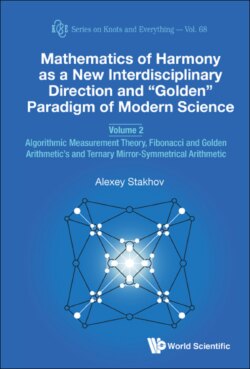Читать книгу Mathematics of Harmony as a New Interdisciplinary Direction and “Golden” Paradigm of Modern Science - Alexey Stakhov - Страница 12
На сайте Литреса книга снята с продажи.
1.2. Axioms of Eudoxus–Archimedes and Cantor
ОглавлениеTo overcome the first crisis in the foundations of ancient mathematics, associated with the discovery of “incommensurable segments”, the outstanding geometer Eudoxus proposed the “method of exhaustion”, by which he built the ingenious theory of relations, underlying the ancient theory of the continuum. “Method of exhaustion” played a prominent role in the development of mathematics. Being a prototype of integral calculus, the “exhaustion method” allowed ancient mathematicians to solve the problems of calculating volumes of a pyramid, a cone, a ball. In modern mathematics, the “method of exhaustion” is reflected in the Eudoxus–Archimedes axiom, also called the measurement axiom.
The theory of measuring geometric quantities, which goes back to “incommensurable segments”, is based on a group of axioms, called continuity axioms [16], which include the Eudoxus–Archimedes and Cantor axioms or the Dedekind axioms.
Eudoxus–Archimedes axiom (the “measurement axiom”). For any two segments A and B (Fig. 1.1), we can find the positive integer n such that
Fig. 1.1. Eudoxus–Archimedes axiom.
Cantor’s axiom (about the “contracted segments”). If an infinite sequence of segments A0B0, A1B1, A2B2, …, AnBn, … “nested” into each other is given (Fig. 1.2), that is, when each segment is part of the previous one, then there is at least one point of C, common to all segments.
Fig. 1.2. Cantor’s axiom.
The main result of the theory of the geometric quantities is the proof of the existence and uniqueness of the solution q of the basic measurement equation:
where V is the unit of measurement, Q is the measurable quantity, and q is the result of measurement.
Despite the seeming simplicity of the axioms, formulated above, and the whole mathematical theory of measurement, it is nonetheless the result of more than 2000 years in the development of mathematics and contains a number of in-depth mathematical ideas and concepts.
First of all, it is necessary to emphasize that the Eudoxus exhaustion method and the measurement axiom, resulting from it (Fig. 1.1), are of practical (empirical) origin; they were borrowed by the ancient Greek mathematicians in the practice of measurement. In particular, the “exhaustion method” is the mathematical model for measuring the volumes of liquids and bulk solids by “exhaustion”; the measurement axiom, in turn, concentrates thousands of years of human experience, long before the emergence of the axiomatic method in mathematics, billions of times measuring distances, areas and time intervals, and is a concise formulation of an algorithm of measuring line segment A by using a segment B (Fig. 1.1). The essence of this algorithm consists in successively postponing the segment B on the segment A and counting the number of segments B that fit on the segment A. In modern measurement practice, this measurement algorithm is called the counting algorithm.
